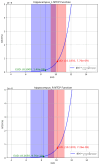Evaluation of hippocampus-sparing VMAT versus conventional VMAT in locally advanced nasopharyngeal carcinoma: a dosimetric and biological analysis
- PMID: 41132719
- PMCID: PMC12540157
- DOI: 10.3389/fonc.2025.1628590
Evaluation of hippocampus-sparing VMAT versus conventional VMAT in locally advanced nasopharyngeal carcinoma: a dosimetric and biological analysis
Abstract
Background and purpose: Radiation-induced hippocampal damage poses a risk of cognitive decline following radiotherapy. Existing international guidelines for nasopharyngeal carcinoma (NPC) radiotherapy provide insufficient specific guidance on hippocampus sparing, which is critically needed, particularly for patients with locally advanced disease. This study was conducted to retrospectively evaluate the dosimetric feasibility and safety of a hippocampus-sparing VMAT technique for locally advanced NPC. Specifically, we assessed its ability to reduce hippocampal dose while ensuring target coverage and respecting dose limits for other organs at risk based on a comparative analysis of treatment plans.
Materials and methods: This retrospective study included the clinical data and treatment plans of 60 patients previously treated for locally advanced nasopharyngeal carcinoma. For all patients, target volumes and organs at risk (OARs) had been delineated according to international guidelines. Notably, for the purpose of this analysis, the left and right hippocampi were meticulously delineated as independent OARs. For this dosimetric comparison, the cohort was divided into two groups: the conventional group (n=30), consisting of patients treated with a conventional VMAT plan, and the hippocampus-sparing group (n=30), for whom HS-VMAT plans were retrospectively analyzed or generated. A systematic comparative analysis of dosimetric and biological data was subsequently conducted between the two groups.
Results: Consistent with previous studies, hippocampus-sparing plans showed statistically significant differences from conventional VMAT plans in multiple parameters, resulting in significantly reduced radiation doses to both the left and right hippocampi. For instance, left hippocampal Dmax was 35.40 Gy compared to 51.15 Gy in conventional plans (a decrease of 15.75 Gy), and right hippocampal Dmax was 36.47 Gy compared to 47.27 Gy (a decrease of 10.8 Gy). Similar significant reductions were observed for Dmean (left: 11.69 Gy vs 16.52 Gy; right: 11.79 Gy vs 16.00 Gy) and D40% (left: 11.38 ± 6.76 Gy vs 16.42 ± 6.99 Gy; right: 11.50 Gy vs 16.62 Gy). However, the Dmin for the left and right hippocampi did not show a significant decrease. Additionally, slight differences in target homogeneity were noted. EUD and NTCP analyses from both groups further demonstrated that reducing hippocampal dose with the hippocampus-sparing plan effectively lowered the predicted probability of complications in the left and right hippocampal tissue.
Conclusion: This retrospective dosimetric comparison demonstrates the feasibility of the hippocampus-sparing technique in patients with locally advanced nasopharmenyngeal carcinoma. Our analysis indicates that HS-VMAT plans can achieve significant reductions in key hippocampal dose parameters, such as Dmax, Dmean, and D40%, while simultaneously maintaining adequate target coverage and adhering to dose constraints for other organs at risk. Supported by both dosimetric and biological (NTCP) analyses, these findings suggest a significantly lower predicted probability of hippocampus-related complications with the HS-VMAT approach. Therefore, our results support HS-VMAT as a theoretically feasible and clinically valuable strategy, with potential significance for preserving the neurocognitive function of patients with locally advanced NPC.
Keywords: EUD; NTCP; hippocampus-sparing volumetric modulated arc therapy; nasopharyngeal carcinoma; volumetric modulated arc therapy.
Copyright © 2025 Liu, Liang, Wu, Tan and Lin.
Conflict of interest statement
The authors declare that the research was conducted in the absence of any commercial or financial relationships that could be construed as a potential conflict of interest.
Figures
References
-
- Chen Y-P, Ismaila N, Chua MLK, Colevas AD, Haddad R, Huang SH, et al. Chemotherapy in combination with radiotherapy for definitive-intent treatment of stage II-IVA nasopharyngeal carcinoma: CSCO and ASCO guideline. J Clin Oncol off J Am Soc Clin Oncol. (2021) 39:840–59. doi: 10.1200/JCO.20.03237, PMID: - DOI - PubMed
-
- Jacob T, Fernandes D, Athiyamaan MS, Rao BS, Shankar S, Vidyasagar MS, et al. Dosimetric evaluation of hippocampus incidental radiation dose in nasopharyngeal cancer patients treated with intensity-modulated radiotherapy. J Radiat Cancer Res. (2020) 11:178. doi: 10.4103/jrcr.jrcr_56_20 - DOI
-
- Zong-wen S, Lei S, Qinglin L, Yue K, Feng-Lei D, Tie-ming X, et al. Results of the radiation dose of head, body and tail of hippocampus in nasopharyngeal carcinoma patients treated with intensity modulated radiotherapy. Sci Rep. (2018) 8:5595. doi: 10.1038/s41598-018-23127-6, PMID: - DOI - PMC - PubMed
LinkOut - more resources
Full Text Sources
Research Materials


